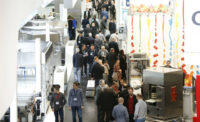Every three years, packaging and processing professionals gather in Dusseldorf, Germany to discover the latest innovations developed by more than 2,700 companies from more than 58 countries.

|
Visitors have an opportunity to review the latest in packaging systems and machinery, packaging materials and confectionery machinery in 19 halls covering more than 2 million square feet net of exhibit space.
At the show’s last staging in 2011, 166,000 visitors from around the world participated in the event. This coming year’s event promises to surpass that number.
For manufacturers of confectionery items, interpack provides a unique opportunity to see suppliers dedicated to confectionery processing and packaging. The latest projections anticipate about 360 exhibitors focused on the confectionery segment.
The mature European confectionery market continues to drive not only consumption, but also to supply confectionery processing equipment throughout the world. Hence, Dusseldorf remains a natural choice as host city for the world’s largest packaging and confectionery processing show.
European Confectionery Update
And let's take a close look at the current state of the European confectionery market.
Germany is the most important market for confectionery in Europe right after Russia.
Currently 1 billion tonnes of confectionery are sold in Germany. In per capita consumption, Germany leads all European countries with 13.3 kg per year, followed by Switzerland and Ireland, each with 12 kg, and the UK with 11 kg.
The demand for confectionery continues unabated in Europe.
Market researchers predict that the demand will rise during the next four years by a total of 4 percent until 2017. Countries with double-digit growth rates are Turkey, with an increase of 13 percent, Spain with 11 percent, Norway and Poland, each with 10 percent.
Within the confectionery segment, chocolate continues to reign as king amongst Europeans. The current sales total (in 2013) amounts to 3.7 million tons, of which more than 60 percent are sold within Western Europe. With a share of almost 20 percent, Germany remains the most important single sales market in Europe after Russia.
Trends affecting product launches
Health benefits: Better-for-you ingredients such as nuts, oats or fruits will become more common. The demand for additive-free chocolate will rise in developed economies. The consumption of dark chocolate will rise due to its health benefits.
Exotica: New recipes and flavours are boosting the demand in developed countries. Combinations of sweet and savoury will increase and salt, oil, herbs and flowers will all be used as flavourings.
Personal touch: Consumers can create “their own personal” chocolate. As consumer palates become more sophisticated, unusual flavors will be normal with chocolate lovers choosing their own combinations. Consumers may also be able to design their own packaging.
Technology for highest quality
Enjoyment and product quality are inseparably linked. Whether chocolates, pralines, biscuits, bars, etc. — it's the quality that makes the difference. The quality of the raw materials and basic ingredients is, however, not the only important factor for the production of high quality products.
Processing and packaging technology are absolutely crucial for product quality. Sophisticated technologies at the highest processing level are used. Machinery and equipment in hygienic design ensure reliable production and extend product shelf life.
For pralines the outward appearance is more important than for any other candy. That’s because before consumers enjoy the taste, they see the artistry, the sophistication. Needless to say, to produce such art in high volumes requires innovative machinery. And each equipment supplier contributes with their own innovations.
For more information, contact Messe Düsseldorf North America, 150 North Michigan Avenue,Suite 2920, Chicago, IL 60601. Telephone: (312) 781-5180; Fax: (312) 781-5188; email: info@mdna.com; website: www.mdna.com.
Interpack Previews









